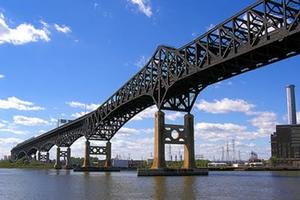InfrastructureU.S. aging bridges in critical condition
There are an estimated 18,000 bridges in the United States that are classed as fracture-critical bridges, requiring continual inspections; the need for increased inspection and maintenance runs against shrinking state and federal budgets for infrastructure improvements; bridges must also be closed for maintenance – but at least for that there is now a solution: instant bridges

New Jersey's Pulaski Skyway // Source: fourtynineandcounting.com
There are an estimated 18,000 bridges in the United States which are classed as fracture-critical bridges, requiring continual inspections.
The American Society of Civil Engineers’ most recent report card gave the condition of bridges in the United States a grade of C. The ASCE notes that 26 percent of U.S. bridges are either structurally deficient or functionally obsolete. They note that as of 2008, the year of the most recent pre-report card survey, one in four bridges in rural areas was deficient, while one in three urban-area bridges are in the same class.
Under ASCE definition, structurally deficient bridges, though not unsafe, must post speed and weight restrictions because of limited structural capacity. A functionally obsolete bridge, though not unsafe either, has older design features and geometrics, and cannot accommodate current traffic volumes, vehicle sizes, and weights.
One such bridge, New York’s 57-year old Tappan Zee bridge spanning the Hudson River, carries 140,000 vehicles a day. Most of the drivers of these vehicles are not aware that the bridge is designed in such a way that if one structural component failed, the entire bridge would collapse.
There is no warning of imminent collapse with this bridge design. There is no swaying or sagging preceding failure. The bridge simply collapses.
The same is true of New Jersey’s Pulaski Skyway, connecting Newark and Jersey City, the San Diego-Coronado Bridge in California, and thousands of other bridges scattered across the United States. All these bridges require regular inspections and monitoring to prevent a disaster similar to the Minneapolis I-35W collapse in 2007.
Businessweekreports the example of the Sherman Minton Bridge that spans the Ohio River between Kentucky and Indiana. In September 2011 inspectors discovered soda can-wide cracks and immediately closed the bridge. The span was reopened this past February after workers had attached 2.4 million pounds of steel reinforcement plate along the span.
A major impediment to the necessary hands-on inspections is that such inspections are labor-intensive, costing as much as fifteen times the cost of a visual inspection done with binoculars. This additional cost comes at a time of dwindling funding for infrastructure maintenance. The ASCE report states that to maintain the current level of bridge conditions, that is, not allowing the number of deficient bridges to increase, would require an investment of $13 billion per year over fifty years. Eliminating all bridge deficiencies as they arise over the next fifty years would increase the annual investment to
